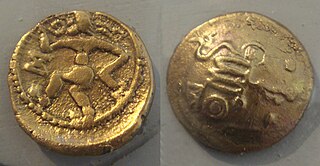Related Research Articles
The Viducassēs were a Gallic tribe dwelling in the modern Calvados department during the Iron Age and the Roman period.

The Petrocorii were a Gallic tribe dwelling in the present-day Périgord region, between the Dordogne and Vézère rivers, during the Iron Age and the Roman period.
The Medulli were a Gallic tribe dwelling in the upper valley of Maurienne, around present-day Modane (Savoie), during the Iron Age and Roman period.
The Alauni were a Gallic tribe dwelling around the lake Chiemsee during the Roman period.
The Nantuates or Nantuatae were a Gallic tribe dwelling around present-day Massongex, in the modern Canton of Valais (Switzerland) and adjacent areas of France, during the Iron Age and the Roman period.

The Bituriges Vivisci were a Gallic tribe dwelling near modern-day Bordeaux during the Roman period. They had a homonym tribe, the Bituriges Cubi in the Berry region, which could indicate a common origin, although there is no direct of evidence of this.

The Namnetes were a Gallic tribe dwelling near the modern city of Nantes during the Iron Age and the Roman period.

The Cocosates or Cocosates Sexsignani were an Aquitani tribe dwelling in present-day Landes during the Iron Age.
The Avantici were a small Gallic tribe dwelling around present-day Gap, in the western part of the modern Hautes-Alpes department, during the Roman period.
The Adanates or Edenates were a small Gallic tribe dwelling around present-day Seyne, in the Alpes Cottiae, during the Iron Age.
The Aneuniates were a small Gallic tribe dwelling near Lake Como, around present-day Samolaco, during the Roman period.
The Segovii were a Gallic tribe dwelling in the Alpes Cottiae, around present-day Cesana Torinese and Montgenèvre, during the Iron Age.
The Venisami or Venisamores were a Gallic tribe dwelling in the Alps during the Iron Age.
The Ambisontes were a Gallic tribe dwelling in the upper Salzach valley during the Roman period.
The Vennones or Vennonetes were a Rhaetian tribe dwelling in the northern Alps, between Chur and Lake Constance, during the Iron Age and the Roman era.
The Vergunni were a Gallic tribe dwelling in the valley of the Riou, near the Verdon river, during the Iron Age.
The Ambilici were a Gallic tribe dwelling in the valley of Gail river during the Roman period.
The Brigianii were a Gallic tribe dwelling around present-day Briançon during the Iron Age and the Roman period.
The Brigantii were a Gallic tribe dwelling southeast of Lake Constance, near present-day Bregenz (Vorarlberg), during the Roman era.
The Benacenses were a Gallic tribe dwelling west of Lake Garda during the Roman period.
References
- ↑ CIL 5:5227.
- 1 2 Falileyev 2010, s.v. Ausuciates.
- ↑ Delamarre 2003, p. 62.
- ↑ Blažek 2017, p. 277.
- ↑ Delamarre 2019, p. 100.
- ↑ Talbert 2000, Map 19: Raetia, Map 39: Mediolanum.
Bibliography
- Blažek, Václav (2017). "Indo-European 'Gold' in Time and Space". Journal of Indo-European Studies. 45 (3/4): 267–311.
- Delamarre, Xavier (2003). Dictionnaire de la langue gauloise: Une approche linguistique du vieux-celtique continental. Errance. ISBN 9782877723695.
- Delamarre, Xavier (2019). Dictionnaire des thèmes nominaux du gaulois. Ab-/Iχs(o)-. Vol. 1. Les Cents Chemins. ISBN 978-1-7980-5040-8.
- Falileyev, Alexander (2010). Dictionary of Continental Celtic Place-names: A Celtic Companion to the Barrington Atlas of the Greek and Roman World. CMCS. ISBN 978-0955718236.
- Talbert, Richard J. A. (2000). Barrington Atlas of the Greek and Roman World. Princeton University Press. ISBN 978-0691031699.
